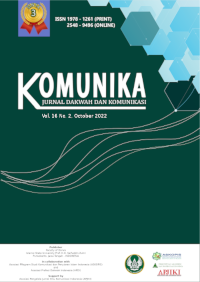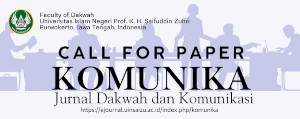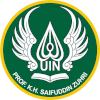Digital Literacy at Pornographic Content and Parent’s Assistance of Early Childhood
DOI:
https://doi.org/10.24090/komunika.v16i1.7049Keywords:
Digital literacy, pornographic content, parental communication, early childhoodAbstract
The use of gadgets in the pandemic era is unavoidable. Distance learning system makes children from an early age to the final-year age use gadgets and online media as a means of information and education. Unfortunately, the data shows that children are accidentally exposed to and susceptible to pornographic content in online media. This makes children need communication and parental assistance in accessing online media. This research was conducted in Semarang private school as a form of community dedication for parents who have an early child. The theory used in this study is the theory of family communication patterns and parental mediation theory. The research method used is mixed methods. The results of this study indicate that parents give their children access to gadgets by giving them screen time. Every respondent also felt concerned about pornographic content. They stated that there is a need for assistance when early childhood access gadgets. Communication in the form of conversation and active mediation between parents and children is a form of parental communication in preventing exposure to pornographic content in online media.Downloads
References
Arnett, Jeffrey Jensen edit. (2007).Encyclopedia of children, adolescents, and the media. London: Sage Publication.
Ayun, Primada Qurrota dan Hedi Pudjo Santosa, (2021). Parental Mediation : Komunikasi Orang Tua Dan Fenomena Cyberbullying Pada Anak. Jurnal Sosfilkom.
Clark, L. S. (2011). Communication Theory: Original Article Parental Mediation Theory for the Digital Age (Denver (ed.)). University of Denver
Creswell, J.W., & Plano Clark, V.L. (2011), Designing and Conducting Mixed Methods Research (2nd ed.). Thousand Oaks, CA: Sage Publications, Inc
Dhafintya Noorca. (2021). Suarasurabaya.net. (https://www.suarasurabaya.net/kelanakota/2021/lebih-dari-60-persen-anak-mengakses-konten-pornografi-melalui-media-online/
Hasugian, J. (2017). Urgensi literasi informasi dalam kurikulum berbasis kompetensi di perguruan tinggi. Pustaha, Vol. 4 No. 2.
Hermoyo, R. P. (2015). Membentuk komunikasi yang efektif pada masa perkembangan anak usia dini. Jurnal Pedagogi, 1(1), Retrieved from http://journal.um-surabaya.ac.id/index.php/Pedagogi/article/view/21
Ishlahudin. (2016). Brilio.Net https://www.brilio.net/serius/100-anak-usia-10-14-tahun-di-indonesia-pengguna-internet-aman-kah-1610257.html)
Kemdikbud. (2018). Materi Pendukung Literasi Digital - Gerakan Literasi Nasional. Jakarta: Depdikbud.
Khalifah, Noor Alika dan Bimo, (2018). Viva.co. (https://www.viva.co.id/gaya-hidup/parenting/1004277-97-persen-dari-4-500-pelajar-smp sma-akses-pornografi).
Koltay, Tibor. (2011). Literacy The media and the literacies: media literacy, information literacy, digital. Journal Media, Culture & Society
Koerner, Ascan F, and Mary Anne Fitzpatrick. (2002). Toward a Theory of Family Communication. Communication Theory.
Kriyantono, R. (2006). Teknik Praktis Riset Komunikasi. Jakarta: PT.Kencana Perdana.
Sugiyono. (2009). Statistika untuk penelitian, Bandung: Alfabetha
Sugiyono. (2011). Metode Penelitian Kuantitatif, Kualitatif dan R&D. Bandung: Afabeta
Munawar, Muniroh, dkk (2019). Keterlibatan Orangtua dalam Pendidikan Literasi Digital Anak Usia Dini. Seminar Nasional. Universitas Negeri Semarang.

Downloads
Published
Issue
Section
License
Copyright (c) 2022 Primada Qurrota Ayun, Hedi Pudjo Santoso, Agus Naryoso, Adi Nugroho, Muh. Yuliyanto

This work is licensed under a Creative Commons Attribution-ShareAlike 4.0 International License.
Authors who publish with this journal agree to the following terms:
- Authors retain copyright and grant the journal right of first publication with the work simultaneously licensed under a Creative Commons Attribution-ShareAlike 4.0 International License that allows others to share the work with an acknowledgement of the work's authorship and initial publication in this journal.
- Authors are able to enter into separate, additional contractual arrangements for the non-exclusive distribution of the journal's published version of the work (e.g., post it to an institutional repository or publish it in a book), with an acknowledgement of its initial publication in this journal.
- Authors are permitted and encouraged to post their work online (e.g., in institutional repositories or on their website) prior to and during the submission process, as it can lead to productive exchanges, as well as earlier and greater citation of published work (See The Effect of Open Access).
























